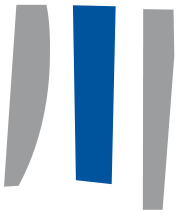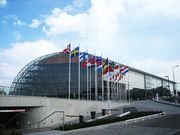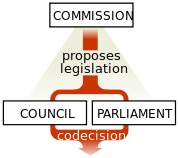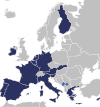European Investment Bank

| European Union |
 This article is part of the series: |
|
Policies and issues
|
|
Foreign relations
|
The European Investment Bank is the European Union's long-term lending institution established in 1958 under the Treaty of Rome. A policy-driven bank, the EIB supports the EU’s priority objectives, especially European integration and the development of economically weak regions. Recently, the Bank has also been actively supporting European R&D projects as part of EU's objective of building the world's leading knowledge-based economy.
The EIB is an international financial institution, a publicly owned bank. Its owners are the Member States of the European Union, who subscribe to the Bank's capital - EUR 164 billion. As shareholders the Member States are represented on the Bank's main independent decision-making bodies - the Board of Governors and the Board of Directors[1]. Since the year 2000 the Bank itself became a member of the EIB Group (including its venture capital arm - the European Investment Fund).
The total subscribed capital of the Bank as of end-2007 was EUR 164 billion, of which EUR 8.2 were actually paid-in. Because on average EIB extends around EUR 50 billion per year in the form of various loan products, the Bank uses its AAA credit rating and funds itself by raising equivalent amounts on the capital markets.
For the fiscal year 2007, EIB approved around EUR 56.5 billion in various loan products of which EUR 48.7 billion were within the EU and EFTA member states with the remainder dispersed between "partner countries" (in accordance with the terms and conditions laid down in the various agreements linking the European Union to some 130 countries in South and Eastern Europe, the Mediterranean region, Africa, Asia, Latin America, the Caribbean and the Pacific).
The headquarters is situated at 100 Boulevard Konrad Adenauer in Kirchberg, Luxembourg. The building's first phase was designed by British architect Sir Denys Lasdun and is one of his few works outside the UK.
In 2007, the EIB opened a regional office in Helsinki, located at the headquarters of the Nordic Investment Bank (NIB), with a view to enhancing the Bank’s presence in the Baltic Sea region [2].
Contents |
Governance

The EIB is governed by the:
- Board of Governors - usually the Finance Ministers of the Member States
- Board of Directors - 28 members (one nominated by each member state and one by the European Commission).[3]:13-14 There are 18 Alternates,[3]:13-14 meaning that some of these positions will be shared by groupings of States.[4] The Board also co-opts a maximum of 6 experts (3 Directors and 3 Alternates),[3]:13-14 who participate in the Board meetings in an advisory capacity, without voting rights.
- Management Committee - the President of the EIB and 8 Vice Presidents
- Audit Committee - 6 members appointed by the Board of Governors
Presidents
- Pietro Campillli (Italy), February 1958 - May 1959
- Paride Formentini (Italy), June 1959 - September 1970
- Yves Le Portz (France), September 1970 - July 1984
- Ernst-Günther Bröder (Germany), August 1984 - March 1993
- Sir Brian Unwin (UK), April 1993 - December 1999
- Philippe Maystadt (Belgium), March 2000 -
See also
- Institutions of the European Union
- European Investment Fund
- Development Finance Institution
Notes and references
- ↑ http://www.eib.org/about/faq/structure/index.htm
- ↑ [1]
- ↑ 3.0 3.1 3.2 (pdf) Statute of the European Investment Bank (and other provisions). EIB. 2009-12-01. ISBN 978-92-861-1003-0). http://www.eib.org/attachments/general/statute/eib_statute_2009_en.pdf. Retrieved 20101-08-16.
- ↑ The alternates are nominated as follows:
- 2 by Germany
- 2 by France
- 2 by Italy
- 2 by the UK
- 1 jointly by Spain and Portugal
- 1 jointly by Belgium, Luxembourg and the Netherlands
- 2 jointly by Denmark, Greece, Ireland and Romania
External links
- Official site of the European Investment Bank
- European Investment Bank European Navigator
- CEE Bankwatch Network's Information pages about European Investment Bank
|
||||||||||||||
|
||||||||||||||||||||||||||||||||||||||||||





